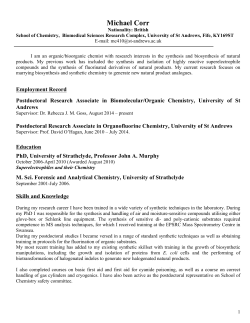
2143607 - Gujarat Technological University
GUJARAT TECHNOLOGICAL UNIVERSITY CHEMICAL TECHNOLOGY (36) UNIT PROCESSES IN ORGANIC SYNTHESIS SUBJECT CODE: 2143607 B.E. 4th SEMESTER Type of Course: Chemical Technology Prerequisite: Basic knowledge of organic chemistry Rationale: The objective of this course is to make students aware of synthesis of different organic chemicals such as alkanes, aldehydes, etc. for understanding the industrial manufacturing processes of various chemical compounds. Teaching and Examination Scheme: Teaching Scheme Credits L T P C 3 0 3 6 Examination Marks Theory Marks Practical Marks ESE PA (M) PA (V) PA (E) (I) PA ALA ESE OEP 70 20 10 20 10 20 Content: Sr. Topics No. Introduction to various Unit Processes such as Nitration, Amination, Hydrogenation, Halogenations, Oxidation, Reduction, Sulphonation 1 and Sulphation, Hydrolysis, Alkylation ,polymerization etc Alkanes, Alkenes, Alkylenes&Haloalkanes: Methods of preparation, 2 properties & uses. Alcohols, Thiols, Ethers &Thioethers: Methods of preparation, 3 properties & uses. Aldehydes & Ketones, Carboxylic acids & Amines: Methods of 4 preparation, properties & uses. Heterocyclic chemistry Introduction-nomenclature-properties-synthesis & reactions involved in 5 five member& six member heterocycles. Heterocycles with one, two or more hetero atoms. Biological importance of heterocycles. Total Marks 150 Teaching Hrs. Module Weightage 8 20 8 20 8 20 10 20 10 20 Suggested Specification table with Marks (Theory): Distribution of Theory Marks R Level U Level A Level N Level E Level Legends: R: Remembrance; U: Understanding; A: Application, N: Analyze and E: Evaluate and above Levels (Revised Bloom’s Taxonomy) Note: This specification table shall be treated as a general guideline for students and teachers. The actual distribution of marks in the question paper may vary slightly from above table Reference Books: 1. 2. 3. 4. 5. 6. 7. Unit Processes in Organic Synthesis, Groggins, Tata McGraw-Hill Education Organic Chemistry, J. McMurry, Brroks / Cole, 5th Ed.,1999 Organic Chemistry ,T. W. Solomons& C. B. Fryhle, John Wiley &Sons.,7th Ed., 2000 Organic Chemistry , G.Marc Loudon, Oxford University Press ,4th Ed. , 2002 Organic Chemistry, L. G. Wade Jr., Pearson Education,5th Ed. , 2003 Organic Chemistry, Volumes I & II, I L Finar, ELBS & Longman Ltd., 5th Ed.,1996 Industrial Aromatic Chemistry: Raw materials, processes, products, H. G. Franck & J. W. Stadehofer, Berlin Springer Verlag, 1st Ed., 1988 Course Outcomes: 1. To express the methods of preparation of various unit processes. 2. To carry out synthesis of various chemical compounds 3. To be able to relate industrial method of preparation with laboratory synthesis. 4. To be able to apply this knowledge in future subjects of chemical technology. 5. To build a bridge between theoretical and practical concept used in industry List of Experiments: 1. 2. 3. 4. 5. 6. 7. 8. 9. 10. Synthesis of polymer Synthesis of Eosin (halogenation) Synthesis of dyes. Synthesis of ester. (esterification) Preparation of ether. Synthesis of m-dinitrobenzene. (nitration) Synthesis of hydrolysis. Study of redox reaction. Preparation of napthol. (sulfonation) Study of reduction reaction. Major Equipment: Distillation assembly, TLC chambers, Mechanical stirrers, oil bath, water bath, glasswares. Open Ended Project fields:Students are free to select any area of science and technology based on chemical technology applications to define Projects. Some suggested projects are listed below: Application of unit processes in industry. Application of chemical products in industry Literature survey of novel methods of preparation. List of Open Source Software/learning website: 1) Delnet ACTIVE LEARNING ASSIGNMENTS: Preparation of power-point slides, which include videos, animations, pictures, graphics for better understanding theory and practical work – The faculty will allocate chapters/ parts of chapters to groups of students so that the entire syllabus to be covered. The power-point slides should be put up on the web-site of the College/ Institute, along with the names of the students of the group, the name of the faculty, Department and College on the first slide. The best three works should submit to GTU.
© Copyright 2025





















